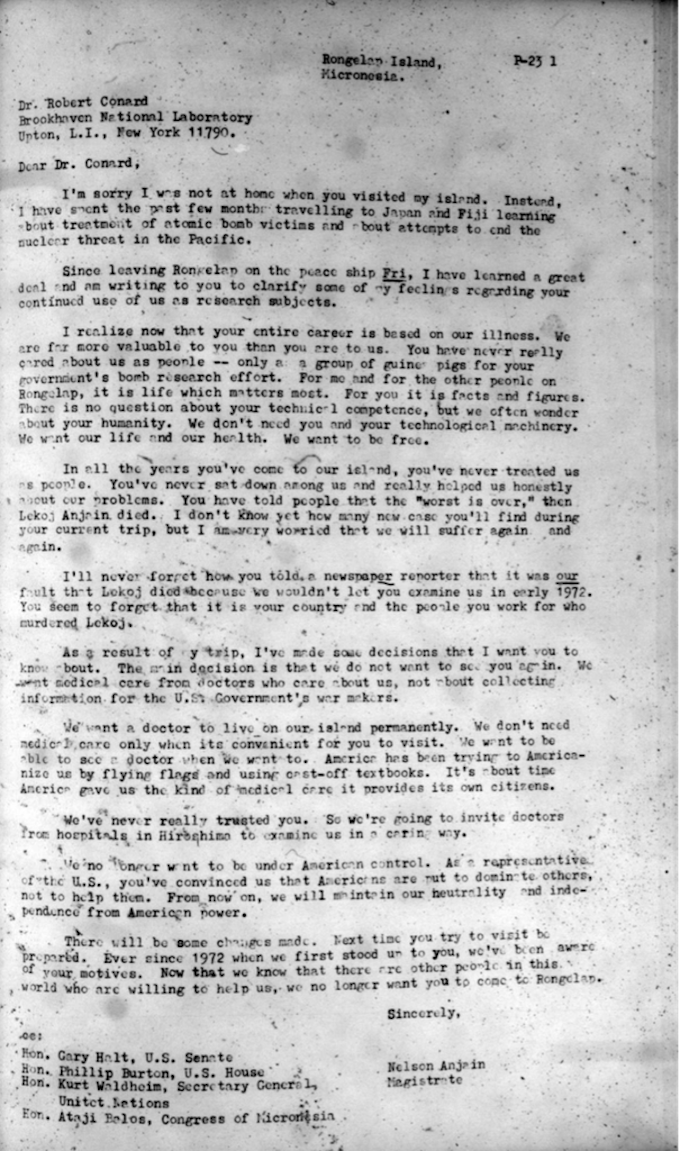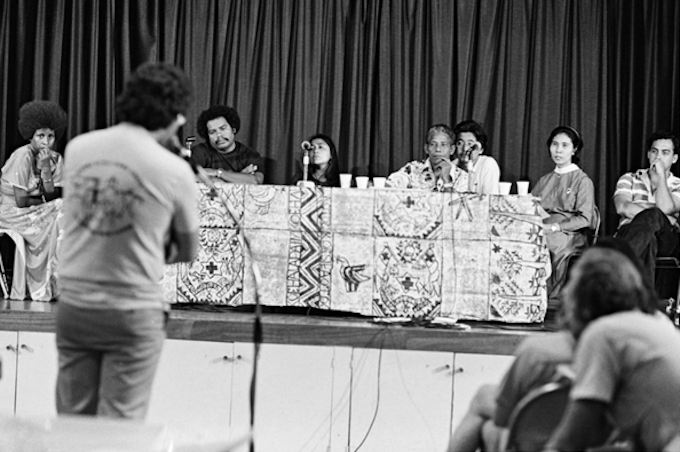SPECIAL REPORT: By Talei Luscia Mangioni
“I realise now that your entire career is based on our illness. We are far more valuable to you than you are to us. You have never really cared about us as people — only as a group of guinea pigs for your government’s bomb research effort. For me and for the other people on Rongelap, it is life which matters most. For you it is facts and figures. There is no question about your technical competence, but we often wonder about your humanity. We don’t need you and your technological machinery. We want our life and our health. We want to be free.” – Nelson Anjain to Dr Robert Conard in 1975.
On Marshall Islands Nuclear Victims Remembrance Day this week, we acknowledge the historical contribution of late Nelson Anjain, a nuclear survivor and champion for nuclear justice in the Pacific.
On this date, 1 March 1954 – 67 years ago, his home of Rongelap Atoll was brutally exposed to radioactive fallout from the hydrogen bomb codenamed Bravo, conducted by the United States government on the nearby Bikini Atoll.
His family had first-hand experience of the bomb. His relative John Anjain recalled the day of the blast:
“…[S]omething very strange happened. It looked like a second sun was rising in the west. We heard a noise like thunder.
“We saw some strange clouds over the horizon … In the afternoon, something began falling from the sky upon our island. It looked like ash from a fire. It fell on me, it fell on my wife, it fell on our infant son.”
The Rongelapese were only evacuated three days after the explosion by American officials. However, three years later in 1957, the people of Rongelap were returned. The United States government falsely assured them of its safety.
Many years later, the Brookhaven National Laboratory’s “expert” on Rongelap and Utirik, an American named Dr Robert Conard had callously stated that the unexposed Rongelapese returning with exposed Rongelapese to fallout in 1957, made an “ideal comparison population” for studying the effects of radiation.
The Rongelapese were considered “convenient guinea pigs” as “the only population to have been exposed to high-level, whole-body radiation without also suffering physical and psychological trauma from the nuclear blast itself, as had been the case in Nagasaki” (Gale, 1973).

In May 1975, as the newly appointed Magistrate of Rongelap, Anjain sent this powerful letter to the American Dr Robert Conard. Anjain had been motivated to write the letter after the tragic passing of his nephew, Lekoj Anjain from leukaemia and witnessing many others in his community suffer from a devastating array of cancers, thyroid, and reproductive health issues.
The original letter was written after Anjain gained regional support for his cause as an activist who travelled (without travel documentation) to Japan and Fiji upon the New Zealand peace yacht Fri in 1975.
Call for victims assistance
Alongside a cadre of Marshallese politicians and activists at the time, he spread the call for victims assistance for the impacted communities, who desperately needed improved financial compensation and medical care for the harms knowingly committed by the US government.
It was a critical time when the Marshall Islands and the rest of the states composing the United States Trust Territory of the Pacific Islands (TTPI) were negotiating their pathways towards political self-determination.
Nelson Anjain attended the Nuclear Free Pacific Conference in Fiji in 1975 alongside a vocal delegation of Micronesian activists: Dino Jones of Guam, Martin San Nicolas of the Northern Marianas, Moses Uludong of Palau, and Carl Young of Guam.
The conference was important in introducing the South Pacific to the North Pacific’s previously unheard of sovereignty struggles.
Nelson Anjain and the American scholar Roger Gale alerted peoples of the South Pacific to the Marshallese’s struggles and recent resistance to American medical racism. In 1971, a team of doctors from the Japan Congress Against Atomic and Hydrogen Bombs attempted to examine them on the invitation of representatives like Ataji Balos for the Congress of Micronesia.
In 1972, the Rongelap people had firmly refused medical examinations by the United States unless independent doctors would do so.
After hearing Anjain’s story and needs, the Conference for a Nuclear Free Pacific with 93 representatives of 22 Pacific and Pacific-rim countries strongly endorsed the Rongelap people’s attempt to gain independent medical aid.

Environmental remediation
Anjain continued to be associated with the regional Nuclear Free Pacific (later renamed to the Nuclear Free and Independent Pacific – NFIP) movement and regularly participated in regional conferences and nurtured connections with Pacific kinfolk within the group. At the significant conference in Hawai’i in 1980, Anjain raised the need for environmental remediation of the oceans and lands. He stated:
“You know, in our islands, everything is contaminated, we just know. But 20 something years ago, doctors told us that everything is all right except coconut crab, but that’s not true. We just found out this year that that’s not true. Many people I know have stomach cancer, thyroid and leukemia, and also when we walk around the island, my feet burn all over.”
This time, he travelled with fellow Marshallese, including Lijon Eknilang and Almira Matayoshi from Rongelap, Norman Matthew from Utirik, and Alvin Jacklick from Kwajalein. Darlene Keju Johnson, who would later become another champion for Marshallese health rights, was also in attendance.
Memorably, this was a transformative experience for all participants. Again, the conference reaffirmed proposals for supporting and carrying out a medical survey independent of the Brookhaven program.
Anjain persists in the regional memory as a fighter for nuclear justice for the Marshallese and the greater Pacific. Through initiating meaningful grassroots connections via kinship gatherings across Asia and the Pacific, Anjain, as global hibakusha, brought the Marshallese plea for justice to international audiences.
Marshallese truth-telling and courage in speaking back to the empire paved the way for vital articulations of the urgent need for victim assistance and environmental remediation.
As we remember the victims of nuclear weapons and acknowledge that further work to repair the harm is still required, we also remember the historical resistance the Marshallese waged and their exceptional offerings to the regional movements for nuclear justice, independence, and demilitarisation in the Pacific.
Talei Luscia Mangioni is currently a PhD candidate at the School of Culture, History and Language, ANU College of Asia and the Pacific. She was born and raised on Gadigal land of the Eora Nation and is of Fijian and Italian descent. Her current scholarship aims to chart the Nuclear Free and Independent Pacific (NFIP) movement across Oceania through historical ethnography, weaving archival records and material objects with oral histories of activists and artists. This article, first published by The New Outrigger, has been republished here with permission of the author.
- Gale, Roger (1973). “Our Radioactive Wards: No One Warned the Micronesians.”
This post was originally published on Asia Pacific Report.